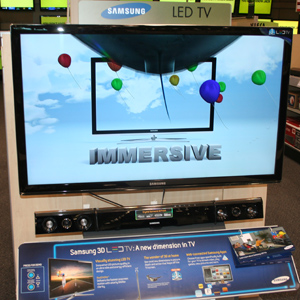Sitting on the couch, one is watching a baseball game. The ball comes flying towards the viewer and he flinches from the realistic appearance. He’s watching the game on a new three-dimensional television.
With 23 3-D movies released in the past year, they’ve made an impact in the market. Until now, having the access to watch television in 3-D was impossible on regular broadcasting cable because scientists were unable to configure the proper technology to create a live 3-D image that could reach the viewers TV.
The 3-D television will help bring the idea of fantasy to reality for it’s viewers. With the help of a pair of glasses, the TV will present its contents in a new light. While wearing glasses to watch TV may be a major turn-off, the positive side of the glasses is that they actually look like Ray Bans, more like a pair of sunglasses than the kind worn in movie theatres. So naturally, one might feel more attractive than the “Average Joe” when wearing the glasses.
Another positive of the television is its amazing high definition quality; not only do the objects on the TV pop out at viewers, but the viewers actually feel like they are sitting in the middle of the action, whether it be watching a Red Sox baseball game or a show on the history of the snail. Either way, one will feel captivated in the TV’s fantastic high definition quality.
However, the price of the TV is a definite drawback. Buying a 3-D TV can cost anywhere from $3,000-$5,000 depending on the make and model. The best bet for a buyer would be to get either a Panasonic or Sony, which are more expensive but give the best quality.
The difficult part about the different brands is each brand has its own set of glasses, meaning that one would not be able to watch his Panasonic TV with a pair of 3-D glasses borrowed from a friend with a Sony brand TV because the glasses are only compatible with the TV they were made for.
Another drawback to the television is that one would have to purchase a Cablevision cable box that gives the viewer access to 3-D channels. There are two 3-D channels available in the United States for the time being, the Discovery Channel and ESPN, which will be broadcast differently than regular cable, with different programs, broadcasters and no advertisements. Cable networks such as Direct TV are working to get more channels to join the 3-D revolution such as CBS, NBC and MTV.
Having only two channels may seem like a reason not to buy the TV, but with other companies working to obtain more stations, one can bet that the future will contain all 3-D channels, as the idea of being immersed in a program is well worth the hype the TV is creating.
Compared to a standard high definition TV, that one might be able to buy, the 3-D TV blows it out of the park. One would feel much more captivated by the realistic nature of the 3-D TV than that of a high definition TV.
The 3-D TV may seem like something too good to be true, but it is definitely going to change society. It will put a new perspective on the way the world watches TV and is definitely worth buying as its positives outweigh its negatives.
